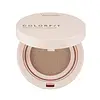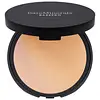Wardah Colorfit Perfect Glow Cushion Versus bareMinerals BarePro 16HR Skin-Perfecting Powder Foundation
What's inside
What's inside
 Key Ingredients
Key Ingredients

 Benefits
Benefits

 Concerns
Concerns

 Ingredients Side-by-side
Ingredients Side-by-side

Water
Skin ConditioningCyclopentasiloxane
EmollientEthylhexyl Methoxycinnamate
UV AbsorberDiphenylsiloxy Phenyl Trimethicone
Skin ConditioningSynthetic Fluorphlogopite
Butylene Glycol
HumectantCaprylic/Capric Triglyceride
MaskingPhenyl Trimethicone
Skin ConditioningEthylhexyl Salicylate
UV AbsorberDimethicone
EmollientLauryl PEG-9 Polydimethylsiloxyethyl Dimethicone
Skin ConditioningTitanium Dioxide
Cosmetic ColorantDisteardimonium Hectorite
StabilisingMagnesium Sulfate
Trehalose
HumectantTrimethylsiloxysilicate
EmollientPEG-10 Dimethicone
Skin ConditioningPhenoxyethanol
PreservativePolyhydroxystearic Acid
EmulsifyingPropylene Carbonate
SolventEthylhexylglycerin
Skin ConditioningDimethicone Crosspolymer
Emulsion StabilisingTriethoxycaprylylsilane
1,2-Hexanediol
Skin ConditioningCaprylyl Glycol
EmollientAcrylates/Behenyl Methacrylate/Dimethicone Methacrylate Copolymer
Skin ConditioningSilica
AbrasiveAluminum Hydroxide
EmollientCentella Asiatica Extract
CleansingAllantoin
Skin ConditioningHydrogenated Lecithin
EmulsifyingCholesterol
EmollientTocopherol
AntioxidantGlycerin
HumectantDisodium EDTA
Cyclotetrasiloxane
EmollientCI 77891
Cosmetic ColorantCI 77492
Cosmetic ColorantCI 77491
Cosmetic ColorantCI 77499
Cosmetic ColorantWater, Cyclopentasiloxane, Ethylhexyl Methoxycinnamate, Diphenylsiloxy Phenyl Trimethicone, Synthetic Fluorphlogopite, Butylene Glycol, Caprylic/Capric Triglyceride, Phenyl Trimethicone, Ethylhexyl Salicylate, Dimethicone, Lauryl PEG-9 Polydimethylsiloxyethyl Dimethicone, Titanium Dioxide, Disteardimonium Hectorite, Magnesium Sulfate, Trehalose, Trimethylsiloxysilicate, PEG-10 Dimethicone, Phenoxyethanol, Polyhydroxystearic Acid, Propylene Carbonate, Ethylhexylglycerin, Dimethicone Crosspolymer, Triethoxycaprylylsilane, 1,2-Hexanediol, Caprylyl Glycol, Acrylates/Behenyl Methacrylate/Dimethicone Methacrylate Copolymer, Silica, Aluminum Hydroxide, Centella Asiatica Extract, Allantoin, Hydrogenated Lecithin, Cholesterol, Tocopherol, Glycerin, Disodium EDTA, Cyclotetrasiloxane, CI 77891, CI 77492, CI 77491, CI 77499
Synthetic Fluorphlogopite
Mica
Cosmetic ColorantCaprylic/Capric Triglyceride
MaskingZinc Oxide
Cosmetic ColorantDiphenyl Dimethicone/Vinyl Diphenyl Dimethicone/Silsesquioxane Crosspolymer
Dimethicone
EmollientSilica
AbrasiveDimethicone Crosspolymer
Emulsion StabilisingZinc Myristate
Boron Nitride
AbsorbentTheobroma Cacao Seed Butter
EmollientDiphenylsiloxy Phenyl Trimethicone
Skin ConditioningCrithmum Maritimum Extract
Skin ConditioningVitis Vinifera Juice Extract
AntioxidantGlycyrrhiza Glabra Root Extract
BleachingAnanas Sativus Fruit Extract
Skin ConditioningButyrospermum Parkii Butter
Skin ConditioningSqualane
EmollientPaeonia Albiflora Root Extract
Skin ConditioningHydrogen Dimethicone
Tocopheryl Acetate
AntioxidantQuercetin
AntioxidantPolysilicone-2
Aluminum Hydroxide
EmollientPolysorbate 80
EmulsifyingMethicone
EmollientSorbitan Sesquiisostearate
EmulsifyingCalcium Silicate
AbsorbentEthylhexylglycerin
Skin ConditioningTocopherol
AntioxidantWater
Skin ConditioningButylene Glycol
HumectantLauroyl Lysine
Skin ConditioningBenzoic Acid
MaskingPhenoxyethanol
PreservativeChlorphenesin
AntimicrobialTitanium Dioxide
Cosmetic ColorantIron Oxides
Synthetic Fluorphlogopite, Mica, Caprylic/Capric Triglyceride, Zinc Oxide, Diphenyl Dimethicone/Vinyl Diphenyl Dimethicone/Silsesquioxane Crosspolymer, Dimethicone, Silica, Dimethicone Crosspolymer, Zinc Myristate, Boron Nitride, Theobroma Cacao Seed Butter, Diphenylsiloxy Phenyl Trimethicone, Crithmum Maritimum Extract, Vitis Vinifera Juice Extract, Glycyrrhiza Glabra Root Extract, Ananas Sativus Fruit Extract, Butyrospermum Parkii Butter, Squalane, Paeonia Albiflora Root Extract, Hydrogen Dimethicone, Tocopheryl Acetate, Quercetin, Polysilicone-2, Aluminum Hydroxide, Polysorbate 80, Methicone, Sorbitan Sesquiisostearate, Calcium Silicate, Ethylhexylglycerin, Tocopherol, Water, Butylene Glycol, Lauroyl Lysine, Benzoic Acid, Phenoxyethanol, Chlorphenesin, Titanium Dioxide, Iron Oxides
 Reviews
Reviews

Ingredients Explained
These ingredients are found in both products.
Ingredients higher up in an ingredient list are typically present in a larger amount.
Aluminum Hydroxide is a form of aluminum. It can be naturally found in nature as the mineral gibbsite. In cosmetics, Aluminum Hydroxide is used as a colorant, pH adjuster, and absorbent.
As a colorant, Aluminum Hydroxide may add opacity, or reduce the transparency. Aluminum hydroxide is contains both basic and acidic properties.
According to manufacturers, this ingredient is an emollient and humectant. This means it helps hydrate the skin.
In medicine, this ingredient is used to help relieve heartburn and help heal ulcers.
There is currently no credible scientific evidence linking aluminum hydroxide in cosmetics to increased cancer risk.
Major health organizations allow the use of aluminum hydroxide in personal care products and have not flagged it as a carcinogenic risk at typical usage levels.
Learn more about Aluminum HydroxideButylene Glycol (or BG) is used within cosmetic products for a few different reasons:
Overall, Butylene Glycol is a safe and well-rounded ingredient that works well with other ingredients.
Though this ingredient works well with most skin types, some people with sensitive skin may experience a reaction such as allergic rashes, closed comedones, or itchiness.
Learn more about Butylene GlycolThis ingredient is an emollient, solvent, and texture enhancer. It is considered a skin-softener by helping the skin prevent moisture loss.
It helps thicken a product's formula and makes it easier to spread by dissolving clumping compounds.
Caprylic Triglyceride is made by combining glycerin with coconut oil, forming a clear liquid.
While there is an assumption Caprylic Triglyceride can clog pores due to it being derived from coconut oil, there is no research supporting this.
Learn more about Caprylic/Capric TriglycerideDimethicone is a type of synthetic silicone created from natural materials such as quartz.
What it does:
Dimethicone comes in different viscosities:
Depending on the viscosity, dimethicone has different properties.
Ingredients lists don't always show which type is used, so we recommend reaching out to the brand if you have questions about the viscosity.
This ingredient is unlikely to cause irritation because it does not get absorbed into skin. However, people with silicone allergies should be careful about using this ingredient.
Note: Dimethicone may contribute to pilling. This is because it is not oil or water soluble, so pilling may occur when layered with products. When mixed with heavy oils in a formula, the outcome is also quite greasy.
Learn more about DimethiconeDimethicone Crosspolymer is a silicone created by modifying dimethicone with hydrocarbon side chains. Due to its large size, it does not penetrate skin. It is considered non-occlusive.
Dimethicone Crosspolymer is used to stabilize and thicken products. It also helps give products a silky feel.
Diphenylsiloxy Phenyl Trimethicone is a silicone. It has a high refractive index and adds shine to formulations.
According to the safety review by the Cosmetic Ingredient Review (CIR) Expert Panel, it is safe for use in cosmetics under the current practices and concentrations.
Ethylhexylglycerin (we can't pronounce this either) is commonly used as a preservative and skin softener. It is derived from glyceryl.
You might see Ethylhexylglycerin often paired with other preservatives such as phenoxyethanol. Ethylhexylglycerin has been found to increase the effectiveness of these other preservatives.
Phenoxyethanol is a preservative that has germicide, antimicrobial, and aromatic properties. Studies show that phenoxyethanol can prevent microbial growth. By itself, it has a scent that is similar to that of a rose.
It's often used in formulations along with Caprylyl Glycol to preserve the shelf life of products.
Silica, also known as silicon dioxide, is a naturally occurring mineral. It is used as a fine, spherical, and porous powder in cosmetics.
Though it has exfoliant properties, the function of silica varies depending on the product.
The unique structure of silica enhances the spreadability and adds smoothness, making it a great texture enhancer.
It is also used as an active carrier, emulsifier, and mattifier due to its ability to absorb excess oil.
In some products, tiny microneedles called spicules are made from silica or hydrolyzed sponge. When you rub them in, they lightly polish away dead skin layers and enhance the penetration of active ingredients.
Learn more about SilicaSynthetic Fluorphlogopite is the synthethic version of mica. It consists of fluorine, aluminum and silicate.
Synthetic Fluorphlogopite is used to add volume to products.
It is considered non-irritating on the skin.
Learn more about Synthetic FluorphlogopiteTitanium dioxide is a mineral UV filter widely used in sunscreens and cosmetics.
It is one of only two UV filters officially classified as “mineral” by regulatory agencies, the other being zinc oxide.
Titanium dioxide provides broad-spectrum protection mostly in the UVB and UVAII range, with some protection in the UVAI range.
While its UVA protection isn’t as strong as zinc oxide’s, the difference is minor.
A common myth is that mineral UV filters reflect UV light. However, modern research shows titanium dioxide absorbs UV radiation like chemical filters (~95% absorption & 5% reflection).
Thanks to its non-irritating nature, titanium dioxide is suitable for sensitive, acne-prone, or redness-prone skin. It is unlikely to cause "eye sting" like other sunscreen ingredients.
A major drawback of this ingredient is its white cast and thick texture. This is why mineral sunscreens often leave a white cast and are less cosmetically elegant than chemical/hybrid sunscreens.
To improve white cast and spreadability, micronized or nano-sized titanium dioxide is often used.
There are ongoing concerns surrounding nano-titanium oxide's impact on marine ecosystems.
There is no conclusive evidence that any form of titanium oxide (or any other sunscreen ingredients) will cause harm to marine ecosystems or coral reefs. The science is still developing but many consumers are keeping a close eye on this issue.
Please note, many destinations have reef-safety sunscreen rules. For instance, the U.S. Virgin Islands advises all visitors to use non-nano mineral sunscreens.
Nano mineral sunscreens once raised safety concerns about absorption into skin.
Extensive research has shown that they do not penetrate healthy or damaged skin; they remain safely on the surface and the top layer of dead skin (stratum corneum).
You'll likely find titanium dioxide bundled with alumina, silica, or dimethicone. These ingredients help make titanium dioxide highly photostable; this prevents it from interacting with other formula components under UV light.
Learn more about Titanium DioxideTocopherol (also known as Vitamin E) is a common antioxidant used to help protect the skin from free-radicals and strengthen the skin barrier. It's also fat soluble - this means our skin is great at absorbing it.
Vitamin E also helps keep your natural skin lipids healthy. Your lipid skin barrier naturally consists of lipids, ceramides, and fatty acids. Vitamin E offers extra protection for your skin’s lipid barrier, keeping your skin healthy and nourished.
Another benefit is a bit of UV protection. Vitamin E helps reduce the damage caused by UVB rays. (It should not replace your sunscreen). Combining it with Vitamin C can decrease sunburned cells and hyperpigmentation after UV exposure.
You might have noticed Vitamin E + C often paired together. This is because it is great at stabilizing Vitamin C. Using the two together helps increase the effectiveness of both ingredients.
There are often claims that Vitamin E can reduce/prevent scarring, but these claims haven't been confirmed by scientific research.
Learn more about TocopherolWater. It's the most common cosmetic ingredient of all. You'll usually see it at the top of ingredient lists, meaning that it makes up the largest part of the product.
So why is it so popular? Water most often acts as a solvent - this means that it helps dissolve other ingredients into the formulation.
You'll also recognize water as that liquid we all need to stay alive. If you see this, drink a glass of water. Stay hydrated!
Learn more about Water